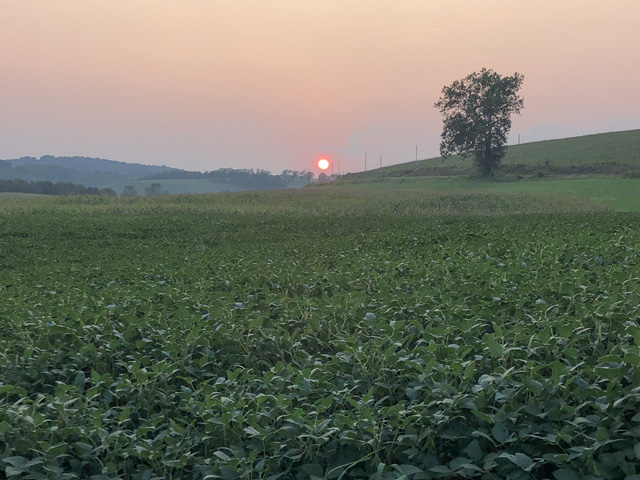Cash Market Moves
Soy Global Trade Exchange and Specialty Grains Conference Goes Virtual
During its first-ever all-virtual event, the U.S. Soy Global Trade Exchange and Specialty Grains Conference on Aug. 24-27 covered global innovations, world soy supply and demand, and the high-quality advantages of U.S. soybeans and specialty grains through live panel discussions, 360-degree farm tours, personalized one-on-one meetings and even a digital trade show.
The U.S. Soybean Export Council (USSEC) and Specialty Soya and Grains Alliance (SSGA) co-hosted 1,000 global customers and soybean industry representatives from 69 countries for the conference. In total, 1,500 people registered, and the conference's digital capability allowed those who were unable to attend live to watch the sessions on-demand following the event.
The conference was livestreamed in several different languages, with attendees hearing from globally recognized experts, U.S. soybean farmers about the 2020 growing season and key leaders from the U.S. Department of Agriculture (USDA) and the Office of the U.S. Trade Representative (USTR) on an array of topics.
One of the sessions held during the event was RFD-TV's "'State of the Industry' Premier and Container Shipping Landscape: The New Reality and State of the Industry."
John Jenkinson, market specialist, RFD-TV, highlighted investments in U.S. transportation infrastructure to ensure more efficient shipping of U.S. soy to our global customers.
"With up to 60% of U.S. soybeans exported through the lower Mississippi ports, efforts continue to ensure a dependable supply of U.S. ag products. This includes a $2-million soy checkoff investment in research, planning, analysis and design to jumpstart the 'Mississippi River Deepening Project.'"
Here is a link to the Soy Transportation Coalition results of a 2018 research project on the benefits of promoting the dredging of the lower river shipping channel from 45 feet to 50 feet in depth: https://www.soytransportation.org/….
P[L1] D[0x0] M[300x250] OOP[F] ADUNIT[] T[]
In turn, the U.S. Army Corps of Engineers and Louisiana Department of Transportation invested in a $245-million dredging initiative that will increase the load by 500,000 bushels per ocean vessel. Jenkinson added that besides the investment in the nation's waterways, nearly $1 billion has been spent in the past 10 years to enhance the Pacific Northwest ag supply chain with increased capacity to new terminals and expansions by rail.
"More efficient shipping builds value in the supply chain and provides easier access for U.S. soy to reach our customers around the world," said Jenkinson.
CONTAINER SHIPPING REBOUNDS
As the global COVID-19 pandemic intensified in China in early March, container shippers became a victim of blank sailings due to containers piling up at ports in China where the pandemic was at its worst. A blank sailing is either a sailing that skips one specific port (while still traversing the rest of the scheduled route) or the entire sailing being canceled.
Canceled sailings and staff shortages at shipping lines and warehouses across Asia, especially in China, limited the volume of Asian exports to the United States, according to SSGA. Spot shortages of containers began surfacing near hubs such as Chicago and Minneapolis, and shippers of identity-preserved soybeans were feeling the pinch during that time.
Bruce Abbe, SSGA strategic adviser for trade and transportation, noted in a July 28 article: "While the first half of 2020 was marked by unprecedented disruptions for international shipping due to the economic effects from COVID-19, the second half of the year is now looking considerably improved with most businesses now operating again. In the longer term, global shipping's future will be shaped by what all strategic supply chain partners can do together to be more proactive with solutions than reactive to shipping problems."
On the second day of the U.S. Soy Global Trade Exchange and Specialty Grains Conference, SSGA led a discussion titled "Container Shipping Landscape -- The New Reality."
The container shipping breakout, sponsored by the Illinois Soybean Association, was moderated by Bob Sinner, president of SB&B Foods, Casselton, North Dakota. Sinner is also SSGA vice-chair and chair of SSGA's competitive shipping action team. Here is a link to SB&B foods to help better understand the food safety, identity preservation and precise traceability of the specialty grains and soybeans shipped to markets around the world: https://sb-b.com/….
The discussion centered on concerns about container availability and quality of containers for inland U.S. exporters and the reliability of on-time service by ocean carriers. Logistics in the areas of truck, rail and ocean shipping were also discussed, especially as consumer demands have changed and the coronavirus pandemic disrupted the marketplace and global supply chains.
One of the important points made was that end users need to carry more inventory in case of a disruption in on-time deliveries as was seen when the pandemic wreaked havoc on container shipments during the first half of 2020.
Panelist Uffe Ostegaard, president, North America, of Hapag-Lloyd, said that, overall, on-time reliability has been improving gradually, although canceled sailings could go up again in the fourth quarter. Ostegaard and panelist Peter Friedmann, executive director of the Agriculture Transportation Coalition, both predicted ocean freight rates for exports to remain stable for the foreseeable future.
Panelist Gene Seroka, executive director of the Port of Los Angeles, advocated for more digital technology such as a data-driven, nationwide port communication system, one that lines up with trucking and rail schedules and could help get containers where they need to be in the rural U.S. and other places of need.
One thing all panelists agreed on was the importance of communication among buyers, suppliers, shippers and transportation providers.
"Communication is the most vital aspect of our business," Roger Mortenson, vice president of Grain Millers Specialty Products, said. "Understanding all the pieces is critical. As U.S. soybean suppliers, we have great relationships with our logistical partners. We are talking, listening and working to support the common goal."
Mary Kennedy can be reached at mary.kennedy@dtn.com
Follow her on Twitter @MaryCKenn
(c) Copyright 2020 DTN, LLC. All rights reserved.



